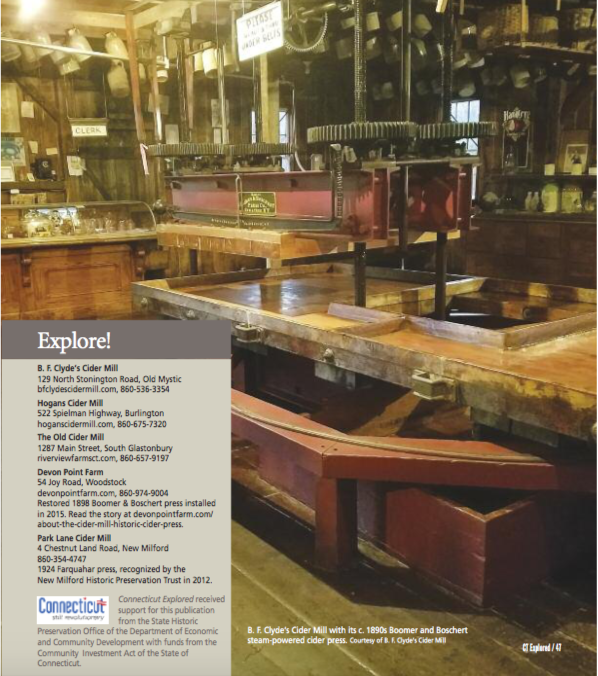By Christopher Pagliuco
(c) Connecticut Explored Inc. Summer 2017
Subscribe/Buy the Issue
As the thick heat of the summer begins to break and New Englanders take in those first deep breaths of the crisp autumn air, it is not long before our thoughts, tongues, and bellies begin to wonder if the apples have begun to ripen. A visit to a historic cider mill—the rumbling of the apples through the chute, the churning of the belts, and the rhythm of the work—evokes the simpler times of days gone by.
At one time, 1 in 10 New England farms operated a cider press, according to Ben Watson in Cider Hard and Sweet: History, Traditions, and Making Your Own (The Countryman Press, 1999); there were 213 such operations in Hartford County alone in the 1820s, according to Leonard Alderman, Burlington’s town historian.
Apples were initially an imported crop, but New England farmers quickly began developing their own varieties. Connecticut could deliver the mineral-rich soil and the number of chilling hours (those during which the temperature is between 32 and 45 degrees) for trees to go dormant that are necessary for bountiful harvests.
Each fall colonists could dependably rely upon copious amounts of nutritious fruit that could be preserved and stored. The Roxbury Russett variety could be stored in a cold cellar, and the Old High Top Sweet could be dried. All apple varieties could be turned into cider as a great method of preservation. Cider grew into an important staple and was shared by all social classes and all ages, from children to the elderly.
By 1767 the per capita consumption of hard cider (cider that has fermented) was 35 gallons per person, compared to about 3.8 gallons of alcohol per year today. New England cider in those days contained between 6 percent and 13 percent alcohol, an important quality because alcohol prevents the growth of bacteria and therefore often made hard cider safer to drink than water. While New Englanders would often sweeten their cider with maple syrup or honey during the fermentation process, it was the tradition of using raisins in a second round of fermentation that most distinguished New England cider, according to Watson, though it is not known if any Connecticut cider producers still do this.
Connecticut can be proud of the few remaining historic cider mills still in operation. The distinguishing feature of B.F. Clyde’s 130-year-old cider operation, operated by the Miner family in Old Mystic, is the Syracuse, New York-built Boomer and Boschert steam-powered cider press built in the 1890s. The press is so rare, it was recognized in 1994 by the American Society of Mechanical Engineers as a National Historic Mechanical Engineering Landmark. The press billows out steam while squeezing tons of apples under 40,000 pounds of pressure.
The Miner family takes care and pride in its family tradition and community. Annette Miner described to me the satisfaction she gets in maintaining an old New England tradition. “You aren’t going to get rich selling apples, but we enjoy the process, we love the product, the people, and the history,” she said.
Hogans Cider Mill, located in Burlington, has been in continuous operation for more than 100 years. Patrick Hogan, the son of Irish immigrants, began making cider in 1912. His son Morris, born in 1902, expanded the farm immensely. Hogans is listed on the Connecticut Register of Historic Places in recognition of its collection of barns and outbuildings, each notable for its architecture.
The Old Cider Mill in Glastonbury lies in the heart of Connecticut. While the cider press itself is not as impressive or even operational as those mentioned above, the Town of Glastonbury makes the claim that it is the oldest continuously operated cider mill in the country, dating to the mid-19th century. The mill does not possess the sterilization updates necessary for commercial production, but it is fired up once a year to continue the tradition. Today the property is leased to Riverview Farms and a vibrant culture is maintained in this beautiful section of the state.
Taking a trip to any of these historic cider mills is to enjoy the Connecticut geography and bounty of another time and place.
Christopher Pagliuco is a history teacher in Madison and author of many works related to Connecticut history and culture. He last wrote “Ivoryton” in the Fall 2008 issue.
Explore!
B. F. Clyde’s Cider Mill
129 North Stonington Road, Old Mystic
bfclydescidermill.com, 860-536-3354
Hogans Cider Mill
522 Spielman Highway, Burlington
hoganscidermill.com, 860-675-7320
The Old Cider Mill
1287 Main Street, South Glastonbury
riverviewfarmsct.com, 860-657-9197
Devon Point Farm
54 Joy Road, Woodstock
devonpointfarm.com, 860-974-9004
Restored 1898 Boomer & Boschert press installed in 2015. Read the story at devonpointfarm.com/about-the-cider-mill-historic-cider-press.
Park Lane Cider Mill
4 Chestnut Land Road, New Milford
860-354-4747
1924 Farquahar press, recognized by the New Milford Historic Preservation Trust in 2012.
 Connecticut Explored received support for this publication from the State Historic Preservation Office of the Department of Economic and Community Development with funds from the Community Investment Act of the State of Connecticut.
Connecticut Explored received support for this publication from the State Historic Preservation Office of the Department of Economic and Community Development with funds from the Community Investment Act of the State of Connecticut.


